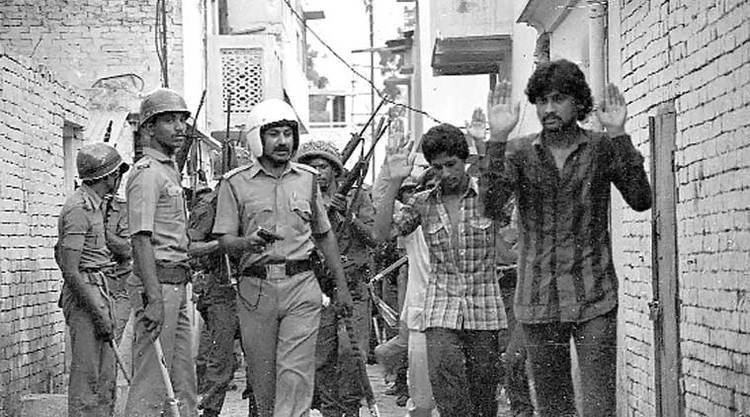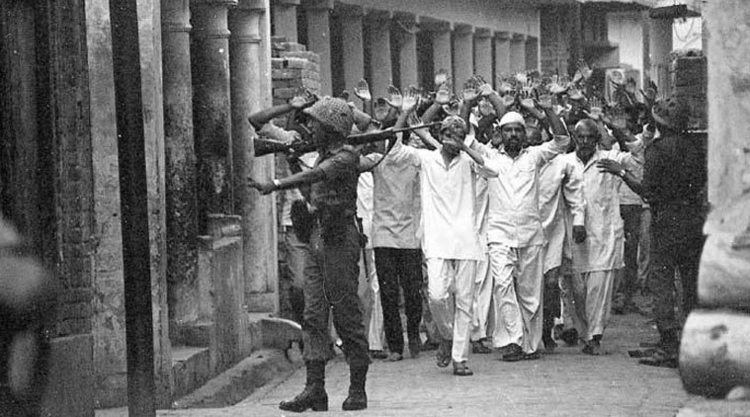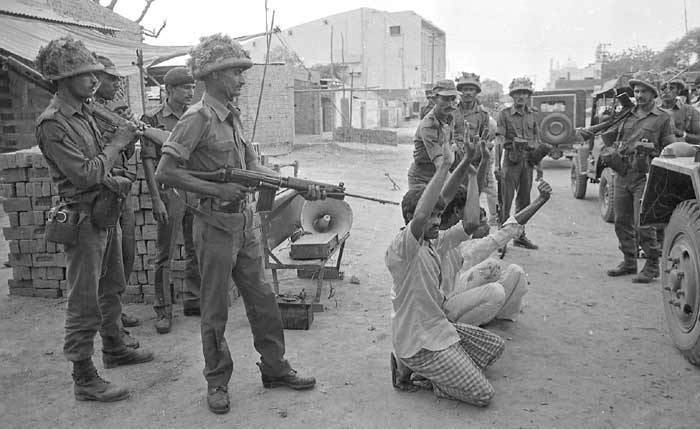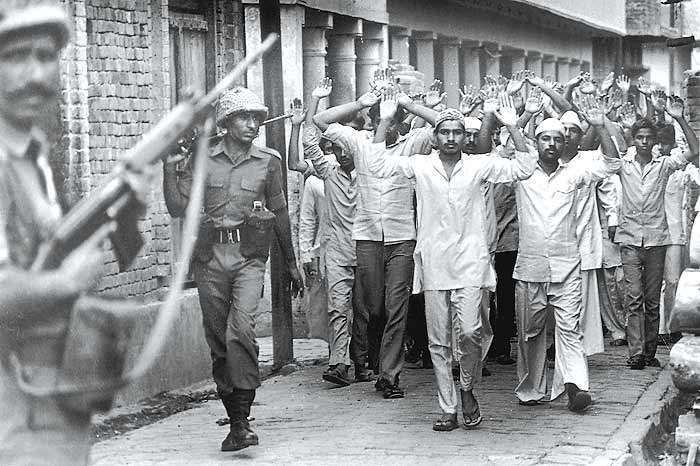Date 22 May 1987 Attack type Shooting Non-fatal injuries 4 | Target Muslim youth Deaths 42 | |
 | ||
Perpetrators | ||
Who killed the victims of the hashimpura massacre of 1987
Hashimpura massacre took place on 22 May 1987, during the Hindu-Muslim riots in Meerut city in Uttar Pradesh state, India, when 19 personnel of the Provincial Armed Constabulary (PAC) allegedly rounded up 42 Muslim youth from the Hashimpura mohalla (locality) of the city, took them in truck to the outskirts, near Murad Nagar, in Ghaziabad district, where they were shot and their bodies were dumped in water canals. A few days later dead bodies were found floating in the canals. In May 2000, 16 of the 19 accused surrendered, and were later released on bail, while 3 were already dead. The trial of the case was transferred by the Supreme Court of India in 2002 from Ghaziabad to a Sessions Court at the Tis Hazari complex in Delhi, where it is the oldest pending case.
Contents

On 24 May 2007, twenty years after the incident, two survivors and members of 36 victim families visited Lucknow and filed 615 applications under The Right to Information Act 2005 (RTI), at the office of Director General of Police seeking information about the case. The inquiry revealed in September that all accused remained in service, and none had any mention of the incident in their Annual Confidential Report (ACR)s. Five men who were shot and survived, later became witness for the prosecution case in 2007.

The incident

After communal riots had taken over Meerut in April 1987, in a communally charged atmosphere ; PAC was called in, but was withdrawn as the riots subsided. However violence erupted again around 19 May, when 10 persons were killed as arson escalated, thus Army was called out to stage a flag march. Seven companies of CRPF has reached the city during the day, while 30 companies of PAC were being rushed in and indefinite curfew was declared. In the following day, mobs burned down Gulmarg cinema hall, and as the death toll rose to 22 and 75 injured, shoot-at-sight orders were issued on 20 May 1987.

On the night of 22 May 1987, 19 PAC personnel, under platoon commander Surinder Pal Singh, rounded up Muslims in the Hashimpur mohalla in Meerut, the old and the children were later separated and let go. Then they allegedly took about 40–45 of them, mostly daily wage labourers and weavers, in a truck to the Upper Ganga canal in Murad Nagar, Ghaziabad district, instead of taking them to the police station. Here some of them were shot, one by one, and thrown into the canal. A bullet also injured one of the PAC constables. After some were killed, the headlights of passing vehicles made PAC personnel flee the spot with those alive. Four of those shot escaped, either by pretending dead and then swimming away, one of them filed a first information report (FIR) at the Murad Nagar Police Station.

The remaining men were next taken in the truck to the Hindon River Canal near Makanpur village in Ghaziabad, shot and their bodies thrown into the canal. Here again, two of the persons who were shot at, survived and lodged an FIR at the Link Road Police Station.
Aftermath

As the news of the incident spread across the media, minority rights organisations and human right organisation voiced their outrage. Prime Minister Rajiv Gandhi visited the city and the riot affected areas on 30 May along with Chief Minister Vir Bahadur Singh . Human rights body, People's Union for Civil Liberties(PUCL) appointed an investigation committee comprising the then President of PUCL (former Justice) Rajindar Sachar, I K Gujral (who later became Prime Minister of India), and others, and the committee brought out its report on 23 June 1987.
In 1988, the Government of Uttar Pradesh ordered an inquiry by the Crime Branch Central Investigation Department (CBCID) of Uttar Pradesh Police. The three-member official investigation team headed by former auditor general Gian Prakash submitted its report in 1994, though it wasn't made public till 1995, when victims moved the Lucknow Bench of the Allahabad High Court.
During the CBCID inquiry, Sub-Inspector Virendra Singh, then in charge of the Link Road Police Station, stated that upon receiving information about the incident he headed towards the Hindon Canal, where he saw a PAC truck heading back from the site. When he chased the truck, he saw it enter 41st Vahini camp of the PAC. Vibhuti Narain Rai, Superintendent of Police, Ghaziabad, and Naseem Zaidi, District Magistrate, Ghaziabad, also reached 41st Vahini and tried tracing the truck through senior PAC officers, but to no avail. In its report, the CB-CID recommended prosecution of 37 employees of the PAC and the police department, and 1 June 1995, the government gave permission for 19 of them to be prosecuted. Subsequently, on 20 May 1997, Chief Minister Mayawati, gave permission for prosecution of the remaining 18 officials.
Court case
After the inquiry, chargesheet was filed with the Chief Judicial Magistrate (CJM), Ghaziabad in 1996 under Section 197 of the Criminal Procedure Code (CrPC), who subsequently issued warrants to the accused policemen to appear before the court. Bailable warrants were issued 23 times against them between 1994 and 2000, yet none of them appeared in court. This was followed by non-bailable warrants which were issued 17 times between April 1998 and April 2000, to no avail. Eventually, under public pressure, 16 of the accused surrendered before the Ghaziabad court in 2000, and were subsequently released on bail and were back in service.
In 2001, after inordinate delay in pre-trial proceedings at Ghaziabad, kins of victims and survivors filed a petition before the Supreme Court for transferring the case from Ghaziabad to New Delhi stating that the conditions there would be more conducive, which the Supreme Court granted in September, 2002. But the case couldn't start, as the state government didn't appoint a Special Public Prosecutor for the case till November 2004, though he was later replaced by S. Adlakha, as the former was found to be under-qualified. Finally, in May 2006, charges were filed against all the accused PAC men for murder, conspiracy to murder, attempt to murder, tampering with evidence etc. under Sections 302/ 120B/ 307/ 201/ 149/ 364/ 148/ 147 of the Indian Penal Code, and the trial listed to begin in July.
On 15 July 2006, the day when the trial was to begin, it was deferred to 22 July by Additional Sessions Judge N P Kaushik of Delhi Sessions Court, after the prosecution said authorities in Uttar Pradesh are yet to send important case material to Delhi. He also issued notices both to the Chief Secretary and Law Secretary of Uttar Pradesh state seeking an explanation as to "why this case has not been dealt with appropriately on an urgent basis". Later, when on 15 July, the trials began, and when one of four survivors, Zulfikar Nasser deposed in front of additional sessions judge N. P. Kaushik at the Tis Hazari, three of the 19 original accused including platoon commander Surender Pal Singh, under whose instructions the massacre was allegedly committed, were already dead. Later on the second day, when the case property was sought by the judge, it was revealed that the rifles used had already been redistributed amongst the jawans of 41-B Vahini Battalion of the PAC (to which the accused belonged), after forensic analysis by CFSL Hyderabad. As per a survivor witness Mohamad Usman, who deposed in February 2007,.."after three boys were pulled out and shot point blank the others in the truck started screaming so the PAC jawans opened fire to quieten them".
By May 2010, 63 of the 161 persons listed as witnesses, by CB-CID of Uttar Pradesh Police, which investigated the case had been examined. On 19 May 2010, 4 witnesses in the case recorded their statements in front of Additional Sessions Judge, Manu Rai Sethi at a Delhi Court. These include Sirajuddin, Abdul Gaffar, Abdul Hamid and the then Officer on Special Duty (OSD) Law and Order G L Sharma. However none of the eyewitnesses could recognize any of the accused PAC personnel.
On 16 October 2012 Janata Party president Subramanian Swamy moved Delhi court seeking probe into the alleged role of Union Minister of State for Home at the time, P.Chidambaram's in the Hashmirpura massacre.
Tis Hazari Court, Delhi on 21 March 2015 acquitted all the 16 accused in the Hashimpura massacre case of 1987, due to insufficient evidences. The Court emphasised that the survivors could not recognize any of the accused PAC personnel.
The Uttar Pradesh Government challenged the order of trial court in Delhi High Court and appealed the decision.Sh Zafaryab Jilani, Additional Advocate General is in charge of the case and Ram Kishor Singh Yadav, Additional Advocate General, Supreme Court is assisting him. Mr. Kaushal Yadav, Advocate-on-Record is Public Prosecutor in the matter.
In May 2015, Uttar Pradesh Government announced a compensation of Rs. 5 lakh to family of each victim.
